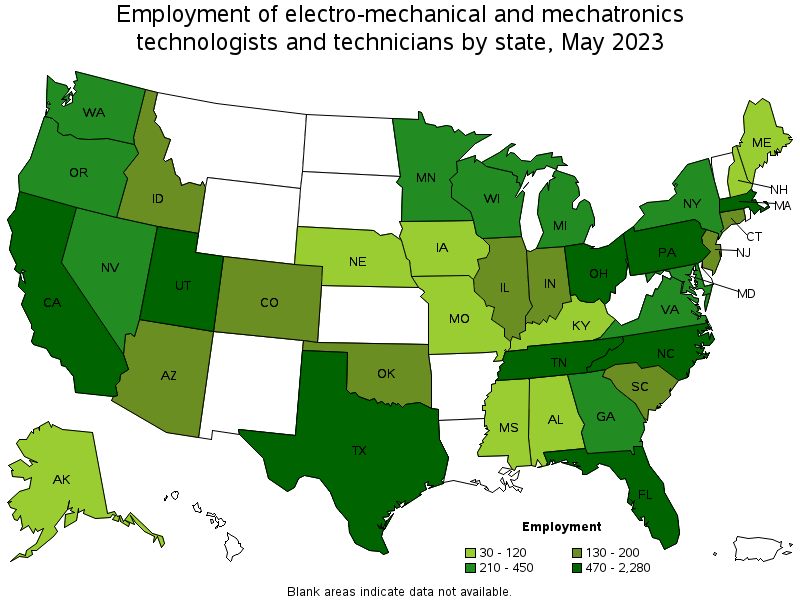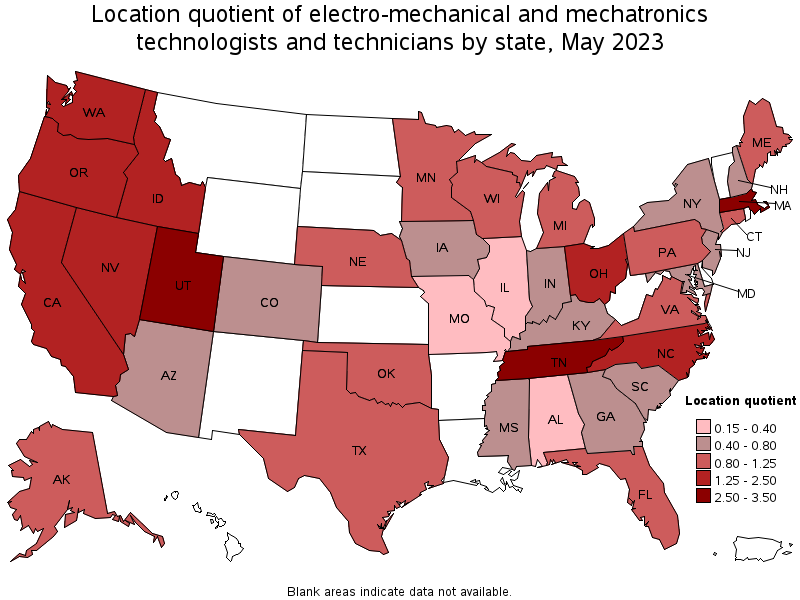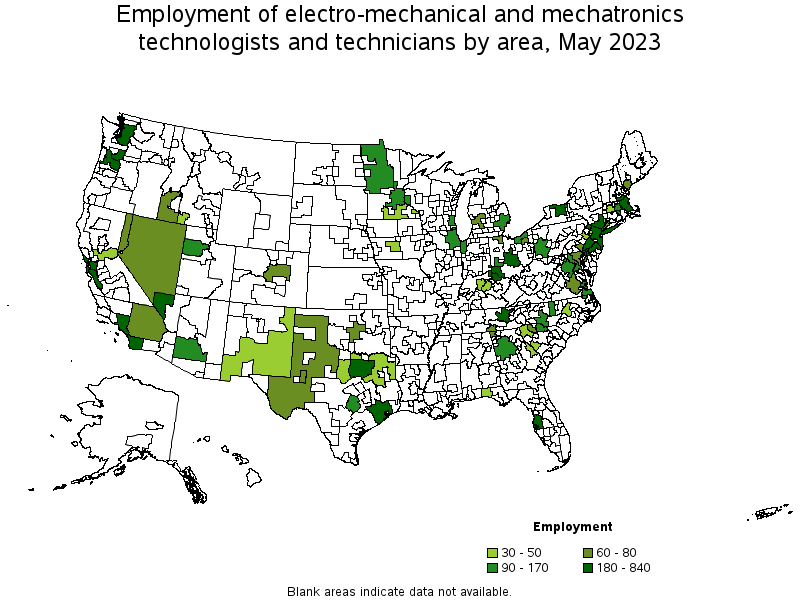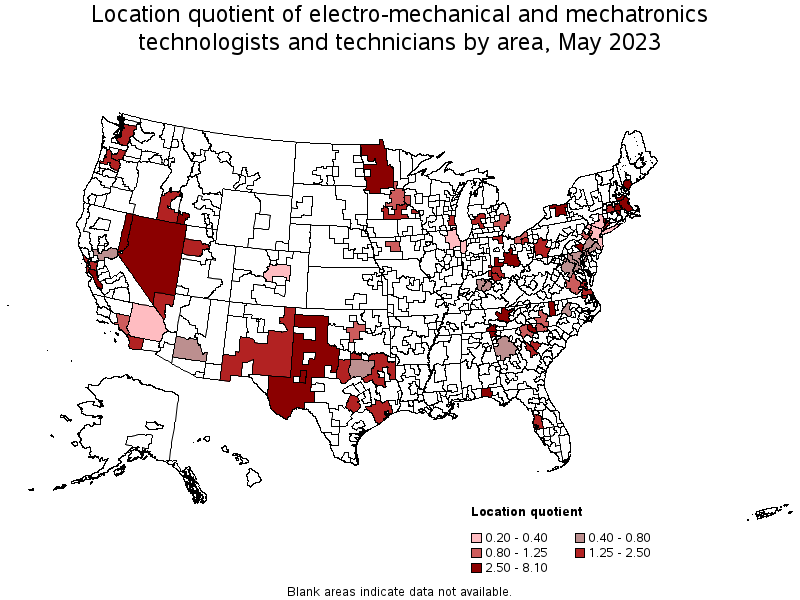An official website of the United States government
 United States Department of Labor
United States Department of Labor
Operate, test, maintain, or adjust unmanned, automated, servomechanical, or electromechanical equipment. May operate unmanned submarines, aircraft, or other equipment to observe or record visual information at sites such as oil rigs, crop fields, buildings, or for similar infrastructure, deep ocean exploration, or hazardous waste removal. May assist engineers in testing and designing robotics equipment.
Employment estimate and mean wage estimates for Electro-Mechanical and Mechatronics Technologists and Technicians:
| Employment (1) | Employment RSE (3) |
Mean hourly wage |
Mean annual wage (2) |
Wage RSE (3) |
|---|---|---|---|---|
| 15,360 | 3.0 % | $ 34.82 | $ 72,430 | 0.9 % |
Percentile wage estimates for Electro-Mechanical and Mechatronics Technologists and Technicians:
| Percentile | 10% | 25% | 50% (Median) |
75% | 90% |
|---|---|---|---|---|---|
| Hourly Wage | $ 21.26 | $ 24.83 | $ 31.29 | $ 39.90 | $ 50.33 |
| Annual Wage (2) | $ 44,210 | $ 51,650 | $ 65,080 | $ 82,990 | $ 104,690 |
Industries with the highest published employment and wages for Electro-Mechanical and Mechatronics Technologists and Technicians are provided. For a list of all industries with employment in Electro-Mechanical and Mechatronics Technologists and Technicians, see the Create Customized Tables function.
Industries with the highest levels of employment in Electro-Mechanical and Mechatronics Technologists and Technicians:
| Industry | Employment (1) | Percent of industry employment | Hourly mean wage | Annual mean wage (2) |
|---|---|---|---|---|
| Architectural, Engineering, and Related Services | 1,920 | 0.12 | $ 37.51 | $ 78,020 |
| Scientific Research and Development Services | 1,690 | 0.18 | $ 40.12 | $ 83,440 |
| Navigational, Measuring, Electromedical, and Control Instruments Manufacturing | 1,360 | 0.32 | $ 28.52 | $ 59,310 |
| Semiconductor and Other Electronic Component Manufacturing | 1,260 | 0.32 | $ 31.07 | $ 64,620 |
| Machinery Manufacturing (3331, 3332, 3334, and 3339 only) | 1,170 | 0.15 | $ 33.14 | $ 68,930 |
Industries with the highest concentration of employment in Electro-Mechanical and Mechatronics Technologists and Technicians:
| Industry | Employment (1) | Percent of industry employment | Hourly mean wage | Annual mean wage (2) |
|---|---|---|---|---|
| Semiconductor and Other Electronic Component Manufacturing | 1,260 | 0.32 | $ 31.07 | $ 64,620 |
| Navigational, Measuring, Electromedical, and Control Instruments Manufacturing | 1,360 | 0.32 | $ 28.52 | $ 59,310 |
| Communications Equipment Manufacturing | 200 | 0.24 | $ 25.28 | $ 52,570 |
| Electronic and Precision Equipment Repair and Maintenance | 230 | 0.22 | $ 27.92 | $ 58,070 |
| Oil and Gas Extraction | 210 | 0.20 | $ 53.48 | $ 111,240 |
Top paying industries for Electro-Mechanical and Mechatronics Technologists and Technicians:
| Industry | Employment (1) | Percent of industry employment | Hourly mean wage | Annual mean wage (2) |
|---|---|---|---|---|
| Electric Power Generation, Transmission and Distribution | 210 | 0.05 | $ 58.94 | $ 122,590 |
| Oil and Gas Extraction | 210 | 0.20 | $ 53.48 | $ 111,240 |
| Petroleum and Coal Products Manufacturing | 60 | 0.05 | $ 48.78 | $ 101,450 |
| Aerospace Product and Parts Manufacturing | 510 | 0.10 | $ 47.26 | $ 98,290 |
| Software Publishers | 40 | 0.01 | $ 43.37 | $ 90,200 |
States and areas with the highest published employment, location quotients, and wages for Electro-Mechanical and Mechatronics Technologists and Technicians are provided. For a list of all areas with employment in Electro-Mechanical and Mechatronics Technologists and Technicians, see the Create Customized Tables function.

States with the highest employment level in Electro-Mechanical and Mechatronics Technologists and Technicians:
| State | Employment (1) | Employment per thousand jobs | Location quotient (9) | Hourly mean wage | Annual mean wage (2) |
|---|---|---|---|---|---|
| California | 2,280 | 0.13 | 1.26 | $ 42.86 | $ 89,150 |
| Texas | 1,370 | 0.10 | 1.00 | $ 33.79 | $ 70,290 |
| Massachusetts | 1,070 | 0.29 | 2.89 | $ 31.90 | $ 66,340 |
| Ohio | 930 | 0.17 | 1.69 | $ 32.50 | $ 67,600 |
| Tennessee | 920 | 0.29 | 2.83 | $ 23.19 | $ 48,230 |

States with the highest concentration of jobs and location quotients in Electro-Mechanical and Mechatronics Technologists and Technicians:
| State | Employment (1) | Employment per thousand jobs | Location quotient (9) | Hourly mean wage | Annual mean wage (2) |
|---|---|---|---|---|---|
| Massachusetts | 1,070 | 0.29 | 2.89 | $ 31.90 | $ 66,340 |
| Tennessee | 920 | 0.29 | 2.83 | $ 23.19 | $ 48,230 |
| Utah | 470 | 0.28 | 2.75 | $ 33.64 | $ 69,980 |
| Nevada | 350 | 0.23 | 2.31 | $ 41.35 | $ 86,000 |
| Idaho | 180 | 0.22 | 2.21 | $ 31.44 | $ 65,390 |

Top paying states for Electro-Mechanical and Mechatronics Technologists and Technicians:
| State | Employment (1) | Employment per thousand jobs | Location quotient (9) | Hourly mean wage | Annual mean wage (2) |
|---|---|---|---|---|---|
| Illinois | 140 | 0.02 | 0.22 | $ 45.49 | $ 94,630 |
| Washington | 450 | 0.13 | 1.28 | $ 43.99 | $ 91,500 |
| California | 2,280 | 0.13 | 1.26 | $ 42.86 | $ 89,150 |
| Connecticut | 200 | 0.12 | 1.17 | $ 42.48 | $ 88,350 |
| Nevada | 350 | 0.23 | 2.31 | $ 41.35 | $ 86,000 |

Metropolitan areas with the highest employment level in Electro-Mechanical and Mechatronics Technologists and Technicians:
| Metropolitan area | Employment (1) | Employment per thousand jobs | Location quotient (9) | Hourly mean wage | Annual mean wage (2) |
|---|---|---|---|---|---|
| Boston-Cambridge-Nashua, MA-NH | 840 | 0.30 | 3.00 | $ 32.09 | $ 66,750 |
| San Jose-Sunnyvale-Santa Clara, CA | 660 | 0.58 | 5.74 | $ 40.95 | $ 85,180 |
| Los Angeles-Long Beach-Anaheim, CA | 580 | 0.09 | 0.93 | $ 40.73 | $ 84,730 |
| San Francisco-Oakland-Hayward, CA | 490 | 0.20 | 2.00 | $ 50.55 | $ 105,140 |
| Houston-The Woodlands-Sugar Land, TX | 420 | 0.13 | 1.31 | $ 38.17 | $ 79,400 |
| Seattle-Tacoma-Bellevue, WA | 420 | 0.20 | 1.98 | $ 44.46 | $ 92,470 |
| Knoxville, TN | 340 | 0.82 | 8.10 | $ 22.92 | $ 47,670 |
| New York-Newark-Jersey City, NY-NJ-PA | 330 | 0.03 | 0.34 | $ 36.73 | $ 76,400 |
| Columbus, OH | 270 | 0.26 | 2.53 | $ 29.86 | $ 62,120 |
| San Diego-Carlsbad, CA | 240 | 0.15 | 1.53 | $ 38.45 | $ 79,970 |

Metropolitan areas with the highest concentration of jobs and location quotients in Electro-Mechanical and Mechatronics Technologists and Technicians:
| Metropolitan area | Employment (1) | Employment per thousand jobs | Location quotient (9) | Hourly mean wage | Annual mean wage (2) |
|---|---|---|---|---|---|
| Knoxville, TN | 340 | 0.82 | 8.10 | $ 22.92 | $ 47,670 |
| Twin Falls, ID | 30 | 0.65 | 6.40 | $ 30.87 | $ 64,210 |
| San Jose-Sunnyvale-Santa Clara, CA | 660 | 0.58 | 5.74 | $ 40.95 | $ 85,180 |
| Danbury, CT | 40 | 0.49 | 4.86 | (8) | (8) |
| Midland, TX | 60 | 0.48 | 4.75 | $ 39.31 | $ 81,770 |
| Rochester, NY | 190 | 0.39 | 3.83 | $ 31.71 | $ 65,960 |
| Worcester, MA-CT | 110 | 0.38 | 3.73 | $ 29.94 | $ 62,270 |
| Spartanburg, SC | 60 | 0.37 | 3.70 | $ 35.07 | $ 72,950 |
| Greensboro-High Point, NC | 130 | 0.35 | 3.50 | $ 25.76 | $ 53,580 |
| Crestview-Fort Walton Beach-Destin, FL | 40 | 0.35 | 3.42 | $ 38.39 | $ 79,840 |

Top paying metropolitan areas for Electro-Mechanical and Mechatronics Technologists and Technicians:
| Metropolitan area | Employment (1) | Employment per thousand jobs | Location quotient (9) | Hourly mean wage | Annual mean wage (2) |
|---|---|---|---|---|---|
| San Francisco-Oakland-Hayward, CA | 490 | 0.20 | 2.00 | $ 50.55 | $ 105,140 |
| Chicago-Naperville-Elgin, IL-IN-WI | 110 | 0.02 | 0.24 | $ 47.22 | $ 98,210 |
| Seattle-Tacoma-Bellevue, WA | 420 | 0.20 | 1.98 | $ 44.46 | $ 92,470 |
| Baltimore-Columbia-Towson, MD | 70 | 0.06 | 0.55 | $ 43.85 | $ 91,210 |
| Riverside-San Bernardino-Ontario, CA | 60 | 0.03 | 0.33 | $ 41.43 | $ 86,170 |
| San Jose-Sunnyvale-Santa Clara, CA | 660 | 0.58 | 5.74 | $ 40.95 | $ 85,180 |
| Sacramento--Roseville--Arden-Arcade, CA | 50 | 0.05 | 0.50 | $ 40.79 | $ 84,850 |
| Los Angeles-Long Beach-Anaheim, CA | 580 | 0.09 | 0.93 | $ 40.73 | $ 84,730 |
| Las Vegas-Henderson-Paradise, NV | 200 | 0.18 | 1.83 | $ 40.49 | $ 84,220 |
| Washington-Arlington-Alexandria, DC-VA-MD-WV | 170 | 0.06 | 0.56 | $ 39.40 | $ 81,940 |
Nonmetropolitan areas with the highest employment in Electro-Mechanical and Mechatronics Technologists and Technicians:
| Nonmetropolitan area | Employment (1) | Employment per thousand jobs | Location quotient (9) | Hourly mean wage | Annual mean wage (2) |
|---|---|---|---|---|---|
| Northwest Minnesota nonmetropolitan area | 120 | 0.61 | 6.05 | $ 23.79 | $ 49,470 |
| Nevada nonmetropolitan area | 70 | 0.72 | 7.14 | $ 47.97 | $ 99,780 |
| West Texas Region of Texas nonmetropolitan area | 70 | 0.34 | 3.34 | $ 43.30 | $ 90,060 |
| North Texas Region of Texas nonmetropolitan area | 40 | 0.15 | 1.48 | $ 24.44 | $ 50,840 |
| Eastern New Mexico nonmetropolitan area | 30 | 0.22 | 2.14 | (8) | (8) |
Nonmetropolitan areas with the highest concentration of jobs and location quotients in Electro-Mechanical and Mechatronics Technologists and Technicians:
| Nonmetropolitan area | Employment (1) | Employment per thousand jobs | Location quotient (9) | Hourly mean wage | Annual mean wage (2) |
|---|---|---|---|---|---|
| Nevada nonmetropolitan area | 70 | 0.72 | 7.14 | $ 47.97 | $ 99,780 |
| Northwest Minnesota nonmetropolitan area | 120 | 0.61 | 6.05 | $ 23.79 | $ 49,470 |
| West Texas Region of Texas nonmetropolitan area | 70 | 0.34 | 3.34 | $ 43.30 | $ 90,060 |
| Southeast Minnesota nonmetropolitan area | 30 | 0.23 | 2.23 | $ 26.39 | $ 54,900 |
| Eastern New Mexico nonmetropolitan area | 30 | 0.22 | 2.14 | (8) | (8) |
Top paying nonmetropolitan areas for Electro-Mechanical and Mechatronics Technologists and Technicians:
| Nonmetropolitan area | Employment (1) | Employment per thousand jobs | Location quotient (9) | Hourly mean wage | Annual mean wage (2) |
|---|---|---|---|---|---|
| Nevada nonmetropolitan area | 70 | 0.72 | 7.14 | $ 47.97 | $ 99,780 |
| West Texas Region of Texas nonmetropolitan area | 70 | 0.34 | 3.34 | $ 43.30 | $ 90,060 |
| Southwest Montana nonmetropolitan area | (8) | (8) | (8) | $ 34.40 | $ 71,560 |
| Southeast Minnesota nonmetropolitan area | 30 | 0.23 | 2.23 | $ 26.39 | $ 54,900 |
| North Texas Region of Texas nonmetropolitan area | 40 | 0.15 | 1.48 | $ 24.44 | $ 50,840 |
These estimates are calculated with data collected from employers in all industry sectors, all metropolitan and nonmetropolitan areas, and all states and the District of Columbia. The top employment and wage figures are provided above. The complete list is available in the downloadable XLS files.
The percentile wage estimate is the value of a wage below which a certain percent of workers fall. The median wage is the 50th percentile wage estimate—50 percent of workers earn less than the median and 50 percent of workers earn more than the median. More about percentile wages.
(1) Estimates for detailed occupations do not sum to the totals because the totals include occupations not shown separately. Estimates do not include self-employed workers.
(2) Annual wages have been calculated by multiplying the hourly mean wage by a "year-round, full-time" hours figure of 2,080 hours; for those occupations where there is not an hourly wage published, the annual wage has been directly calculated from the reported survey data.
(3) The relative standard error (RSE) is a measure of the reliability of a survey statistic. The smaller the relative standard error, the more precise the estimate.
(8) Estimate not released.
(9) The location quotient is the ratio of the area concentration of occupational employment to the national average concentration. A location quotient greater than one indicates the occupation has a higher share of employment than average, and a location quotient less than one indicates the occupation is less prevalent in the area than average.
Other OEWS estimates and related information:
May 2023 National Occupational Employment and Wage Estimates
May 2023 State Occupational Employment and Wage Estimates
May 2023 Metropolitan and Nonmetropolitan Area Occupational Employment and Wage Estimates
May 2023 National Industry-Specific Occupational Employment and Wage Estimates
Last Modified Date: April 3, 2024